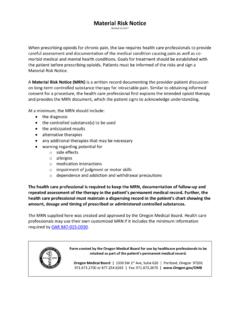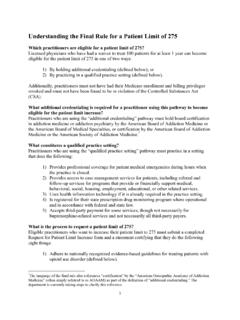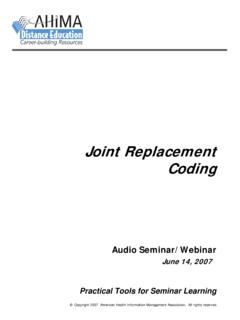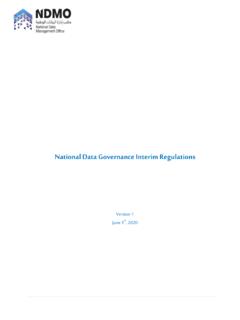Transcription of Guidelines for Documentation of Occupational Therapy
1 7212410010p1 Guidelines for Documentation of Occupational TherapyDocumentation of Occupational Therapy services is required whenever professional services are provided to a Occupational Therapy practitioners2 identify the types of Documentation required and record all necessary components of services provided within their scope of practice. This document, based on the Occupational Therapy Practice Framework: Domain and Process (3rd ed.; American Occupational Therapy Association [AOTA], 2014b), describes the purpose, types, and content of professional Documentation used in Occupational s (2015c) Standards of Practice for Occupational Therapy states that an Occupational Therapy practitioner documents the Occupational Therapy services and abides by the time frames, formats, and standards es-tablished by practice settings, federal and state laws, other regulatory and payer requirements, external accreditation programs, and AOTA documents (p.)
2 4). These requirements apply to both electronic and written forms of Documentation though may vary considerably by practice setting and facility. AOTA s (2015a) Occupational Therapy Code of Ethics states that Occupational Therapy practitioners shall promote fairness and objectivity in the provision of Occupational Therapy services (p. 5) and shall provide com-prehensive, accurate, and objective information when representing the profession (p. 6). Occupational Therapy Documentation reflects the nature of services provided, shows the clinical reason-ing of the Occupational Therapy practitioner, and provides enough information to ensure that services are delivered in a safe and effective manner. Documentation describes the depth and breadth of services pro-vided to meet the complexity of client needs and responses to Occupational Therapy services at the individ-ual, group (community), or population purpose of Documentation is to Communicate information about the client s Occupational history and experiences, interests, values, and needs; Articulate the rationale for provision of Occupational Therapy services and the relationship of those ser-vices to client outcomes; Provide a clear chronological record of client status, the nature of Occupational Therapy services provided, client response to Occupational Therapy intervention, and client outcomes; and Provide an accurate justification for skilled Occupational Therapy service necessity and this document, client may refer to persons, groups, and populations (AOTA, 2014b).
3 2 When the term Occupational Therapy practitioner is used in this document, it refers to both Occupational therapists and Occupational Therapy assistants (AOTA, 2015b). Occupational therapists are responsible for all aspects of Occupational Therapy service delivery and are accountable for the safety and effectiveness of the Occupational Therapy service delivery process. Occupational Therapy assistants deliver Occupational Therapy services under the supervision of and in partnership with an Occupational therapist (AOTA, 2014a).The American Journal of Occupational Therapy7212410010p17212410010p1 The American Journal of Occupational TherapyDownloaded From: on 11/06/2018 Terms of Use: 2018, Volume 72(Supplement 2)7212410010p2 The RefeRence Manual of The official DocuMenTs of The aMeRican Occupational Therapy as so ci a Tion, inc. 7212410010p2 November/December 2018, Volume 72(Supplement 2)Types of DocumentationDocumentation of Occupational Therapy service is maintained in a professional and legal fashion ( , com-plete, concise, accurate, timely, legible, clear, grammatically correct, objective) for each client served.
4 Table 1 outlines common types of Documentation used by Occupational Therapy practitioners. Documentation types may be identified differently or combined and reorganized to meet the specific needs of the client and setting. Occupational Therapy Documentation provides a record of the practitioner s ac-tivity in the areas of screening, evaluation and reevaluation, intervention, and outcomes (AOTA, 2014b) in accordance with practice Guidelines and payer , facility, and state and federal Guidelines and requirements. In addition, Box 1 lists the fundamental elements of of DocumentationI. Screening Report Documents the referral source and the reason for Occupational Therapy Referral information Date and source of referral, services requested, and reason for Client information Description of client s Occupational history, experiences, and performance; health status; and applicable medical, educational, and developmental diagnoses, precautions, and Brief Occupational profile Client s reason for seeking Occupational Therapy services; areas of occu-pation in which the client is successful and challenged; contexts and environments that support and hinder Occupational performance ( , patterns of living, interest, values); medical, educa-tional, and work history; client s priorities; and targeted goals (AOTA, 2017).
5 Table 1. Common Types of Occupational Therapy DocumentationProcess AreaTypeI. ScreeningA. Screening ReportII. Evaluation/ReevaluationA. Evaluation ReportB. Reevaluation ReportIII. InterventionA. Intervention PlanB. Contact ReportC. Progress ReportD. Transition PlanIV. OutcomesA. Discharge/Discontinuation ReportBox 1. Fundamentals of Documentation Documentation practices and storage and disposal of Documentation must meet all state and federal regulations and Guidelines , payer and facility requirements, practice Guidelines , and confidentiality requirements. Client s full name, date of birth, gender, and case number, if applicable, are included on each page of the Documentation . Identification of type of Documentation and the date service is provided and Documentation is completed are included in the Documentation . Acceptable terminology, acronyms, and abbreviations are defined and used within the boundaries of the setting. Clear rationale for the purpose, value, and necessity of skilled Occupational Therapy services is provided.
6 The client s diagnosis or prognosis is not the sole rationale for Occupational Therapy services. Professional signature (first name or initial, last name) and credential; cosignature and credential when required for Documentation of supervision; and, when necessary, signature of the recorder are included with each Documentation entry. All errors are noted and initialed or From: on 11/06/2018 Terms of Use: American Journal of Occupational Guidelines 7212410010p3D. Assessments used (if any) and results Types of assessments used and results ( , interviews, record reviews, observations).E. Recommendation Professional judgments regarding need for complete Occupational Therapy evaluation, based on results of the Evaluation Report Documents the referral source and data gathered through the Occupational Therapy evaluation Referral information Date and source of referral, services requested, and reason for Client information Description of client s Occupational history, experiences, and performance; health status and previous services required and accessed; and applicable medical, educational, and developmental diagnoses, precautions, and Occupational profile Client s reason for seeking Occupational Therapy services; areas of occupa-tion in which the client is successful and challenged; contexts and environments that support and hinder Occupational performance; medical, educational, and work history; Occupational and psy-chosocial history ( , patterns of living, interest, values).
7 Client s priorities; and targeted goals (AOTA, 2017).D. Assessments used and results Types of assessments used ( , interviews, record reviews, obser-vations, standardized or nonstandardized3 assessments) and description of Analysis of Occupational performance Analysis of Occupational performance and identification of factors that support and hinder performance and participation (objective and measurable identification of performance skills, performance patterns, contexts and environments, activity demands, outcomes from standardized or nonstandardized assessments, and client factors).F. Summary and analysis Interpretation and summary of the Occupational profile and Occupational performance issues, identification of targeted areas of occupation and Occupational performance to be addressed, and expected outcomes. The American Medical Association s (2018) Current Procedural Terminology (CPT) requires that procedural codes based on levels of complexity (low, moderate, high) be identified for the three main components of the Occupational Therapy evalu-ation: (1) Occupational profile and medical and Therapy history, (2) assessments of Occupational performance (including identification of performance deficits to be addressed in the plan of care), and (3) clinical decision making.
8 Medicare, Medicaid, and other insurance providers and payers use these codes to identify service reimbursement (Centers for Medicare and Medicaid Services [CMS], 2017a).When required for clients covered by Medicare or Medicaid, data on the client s primary func-tional limitation is reported in the form of quality data codes (G-codes) with their corresponding severity and Therapy modifiers (CMS, 2017b). Functional limitation reporting (FLR) provides G-codes in the areas of mobility and self-care. When addressing population health needs, an environmental scan or SWOT (strengths, weaknesses, opportunities, threats) is often used to document the summary and analysis (Jacobs, Van Witteloostuijn, & Christe-Zeyse, 2013). G. Recommendation Judgment regarding necessity for skilled Occupational Therapy services or oth-er Reevaluation Report Documents the Occupational Therapy reevaluation process. Continual assessment is a component of ongoing Therapy services.
9 Formal reevaluation is conducted when, 3 Nonstandardized assessment tools are considered a valid form of information gathering that allows for flexibility and individual-ization when measuring outcomes related to the status of an individual or group through an intrapersonal comparison. Although not uniform in administration or scoring or possessing full and complete psychometric data, nonstandardized assessment tools have strong internal validity and represent an evidence-based approach to Occupational Therapy practice (Hinojosa, Kramer, & Christ, 2010). Nonstandardized tools should be selected on the basis of the best available evidence and the clinical reasoning of the occupa-tional American Journal of Occupational Therapy7212410010p3 Downloaded From: on 11/06/2018 Terms of Use: 2018, Volume 72(Supplement 2)7212410010p4 The RefeRence Manual of The official DocuMenTs of The aMeRican Occupational Therapy as so ci a Tion, inc.
10 7212410010p4 November/December 2018, Volume 72(Supplement 2)in the professional judgment of the Occupational therapist, new clinical findings emerge, a signif-icant change in the patient s condition requiring further tests and measures is observed, the client demonstrates a lack of response as expected in the plan of care, or additional information is required for discharge (CMS, 2017b) or when required by practice Guidelines and payer , facility, and state and federal Guidelines and Client information Description of client s Occupational history, experiences, and performance; health status; and applicable medical, educational, and developmental diagnoses, precautions, and Occupational profile Updates on current areas of occupation that are successful and problematic; contexts and environments that support or hinder occupations; summary of any new medical, educational, and work information; and updates or changes to client s priorities and targeted outcomes (AOTA, 2017).













